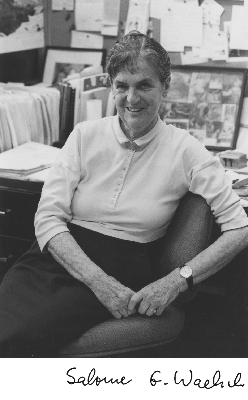Salome Gluecksohn-Waelsch facts for kids
Quick facts for kids
Salome Gluecksohn-Waelsch
|
|
|---|---|
 |
|
| Born | October 6, 1907 |
| Died | November 7, 2007 (aged 100) |
| Occupation | Geneticist |
Salome Gluecksohn-Waelsch (October 6, 1907 – November 7, 2007) was a famous geneticist. She was born in Germany and later moved to the United States. She helped create a new field called developmental genetics. This field studies how genes control the growth and development of living things.
Her Early Life
Salome Gluecksohn-Waelsch was born in Danzig, Germany. This was a difficult time in Germany, between World War I and World War II. Her family faced many challenges. Her father died during the 1918 flu epidemic. There was also a lot of inflation, meaning money lost its value. Her family also faced strong anti-Jewish feelings.
She studied chemistry and zoology in Königsberg and Berlin. In 1928, she joined a lab at the University of Freiburg. Her professor, Hans Spemann, did not believe that genetics and development were connected. He also had prejudices against women and Jewish scientists. Salome kept her different ideas quiet for a while.
In 1932, she earned her doctorate degree from the University of Freiburg. Her work was about how the limbs of salamanders develop. In the same year, she married biochemist Rudolph Schönheimer. They both left Nazi Germany in 1933 to escape the Nazi regime.
Moving to the United States
In 1936, Salome became a lecturer at Columbia University in the United States. She worked in Leslie C. Dunn's genetics lab for 17 years. She looked for mutations that affected early development. She wanted to find out how these genes worked.
She became a U.S. citizen in 1938. After her first husband passed away, she married neurochemist Heinrich Waelsch in 1943. They had two children together.
Columbia University did not offer her a full professor position, even after many years of important research. So, in 1953, she left Columbia. She became a professor at the new Albert Einstein College of Medicine (AECOM). She became a full professor there in 1958. From 1963 to 1976, she led the molecular genetics department. She officially retired in 1978. However, she kept doing research and going to science meetings until the 1990s.
She passed away in New York City in 2007, just one month after her 100th birthday.
Her Scientific Work
Salome Gluecksohn-Waelsch's scientific career began when she was hired to study mice with a special gene change called a 'T locus' mutation. She showed that this gene helped in the early development of the embryo.
She studied cell differentiation. This is the process where cells from a fertilized egg become different types of cells. For example, some become skin cells and others become bone cells. Salome combined her knowledge of embryology with mouse genetics. This made her the founder of mammalian developmental genetics. This field studies how mammals develop from a single cell. She wrote over 100 scientific papers on this topic.
Her research showed that changes in a gene called Brachyury in mice caused problems in the back part of the embryo. She found that this gene affected the notochord, which is important for shaping the embryo.
Awards and Honors
Salome Gluecksohn-Waelsch received many awards later in her life.
- In 1979, she became a member of the National Academy of Sciences.
- In 1980, she was chosen as a Fellow of the American Academy of Arts and Sciences.
- In 1982, the University of Freiburg honored her with the "Goldene Promotion."
- In 1993, U.S. President Bill Clinton gave her the National Medal of Science. This is one of the highest science awards in the U.S.
- In 1995, she became an overseas member of the Royal Society in the UK.
- In 1999, she received the Thomas Hunt Morgan Medal for her lifetime contributions to genetics.
In 2010, the Spemann Graduate School of Biology and Medicine and AECOM created the Salome Gluecksohn-Waelsch Prize. This award is given for the best research paper.
See also
 In Spanish: Salome Gluecksohn-Schoenheimer para niños
In Spanish: Salome Gluecksohn-Schoenheimer para niños

